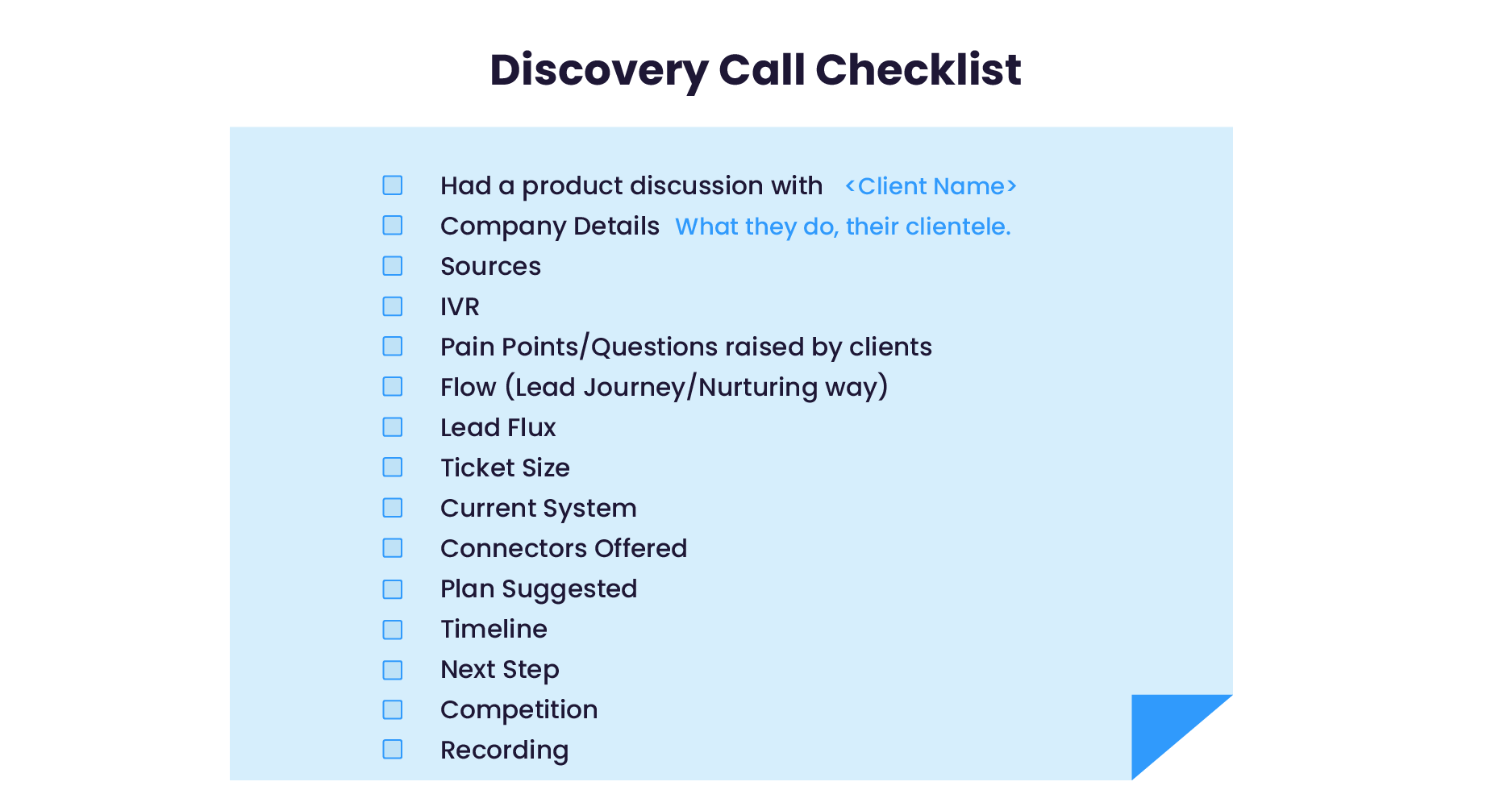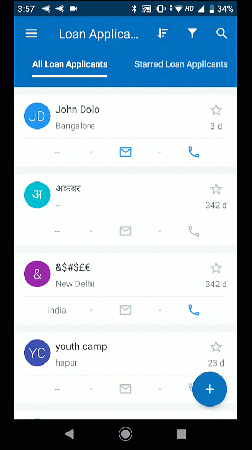“You will never get a second chance to make a first impression.”
Will Rogers
You’ve done all the work: studied the company, scouted a prospect, connected on LinkedIn, and sent a couple mails. Voila! The prospect is interested in your offering. But now what? How do you bring them into your sales process?
This is where discovery calls come in. They enable you to build relationships with prospects, understand their needs and absorb them into your sales process. However, too often, sales reps go about it the wrong way. They are either too pushy about giving a demo or just keep pitching their product.
A discovery call is not an interview, nor a sales pitch, it’s a conversation. This call is the first step of your sales process, and you need to ensure you hit the right spots to increase your chances of closing.
Filled with insights from LeadSquared sales leader Hiral Shah and discovery call specialist Ravish Kumar, this article will help you learn what a discovery call is, why it is important, and a 5-step discovery flow you can implement for your next sales discovery call.
What is a discovery call?
A discovery call is the first conversation your sales team (usually SDRs) have with a prospect after they show an early interest in your product. It provides an opportunity to understand the customer’s situation, needs and goals. This information can help you determine if they are a good fit for your business and subsequently explain how your product can solve their challenges.
For the seller, the discovery call is where you qualify and gather your lead’s requirements. For the buyer, the discovery call helps gauge whether the product will be able to solve the problems they currently face.
The importance of discovery call
A discovery call is where a customer interacts with your team for the first time and develops an initial understanding of your solution. Essentially, this is the first moment of truth for a potential buyer. A good discovery call helps set the stage, build a rapport with the prospect, and make a great first impression.
- From the seller’s POV, the most important function of a discovery call is to gather the requirements needed to take the sales process forward. This helps you qualify your prospect, and acquire all the information your sales team would need to prepare a personalized demo.
- A sales discovery call is a great opportunity to provide value to your prospects, which can help establish authority and build credibility. A sales rep should offer relevant solutions to the prospect’s pain points. It creates a positive experience for the prospect and increases the likelihood of them going forward with the sales process.
3 Things to ensure before you begin the discovery process
1. Create a checklist of all the details you’d like to know
As mentioned above, requirement gathering is an important aspect of a discovery call. An ideal call should leave you with all the information you need to carry forward the sales process.
While preparing for a discovery call, create a checklist of all the details you’d like to know about your prospect’s business. This ensures no critical information is missed out and it reduces the chances of future hurdles which may come up as you go forward.
The checklist you curate depends upon your product/service. Generally, it should include all the things your sales team would require in order to provide a custom demo. You can also create multiple checklists depending on industry or use-case.
As an example, here’s a sample discovery call checklist for sales-led organizations.

Pro Tip: As important requirement gathering is, do not bombard your prospect with one question after another. Allow sufficient time for discussions in between and ensure a two-way conversation.
2. Do your research beforehand
Before you get on the call, do your homework and get to know your prospect and their business.
You can learn about your prospect on social media sites like LinkedIn to find common points to connect on: Are you both alumni from the same university? Do you share a mutual friend? If your prospect finds you relatable, they’re more likely to trust you and share their problems. You could also congratulate them on a recent achievement or talk about their latest LinkedIn post to break the ice.
More importantly, do your research on the prospect’s business. You can develop a decent understanding of a business through information available on LinkedIn, their website and other customer reporting tools. Knowing about the business enables you to:
- Ask better and more meaningful questions.
- Have a rough idea about critical aspects in case the prospect isn’t comfortable sharing information.
Before the discovery call, verify any information that’s associated with the lead in your company’s lead management system. Double-check all information to make sure you’re well acquainted about your prospect.
3. Set up a system for a faster discovery process
Here’s a simple equation, the more discovery calls you make, the more chances of getting a demo and subsequently a sale.
But here’s the catch. Getting around to a discovery call isn’t easy. Farming leads, cold calling, sharing content, scheduling meetings, and recording the call are just some of the tasks your sales reps may have to do inorder to execute a discovery call.
You can, and you should, set up a system to automate this grunt work and get things done at one place. This will enable your reps to focus on the one thing which matters, doing as many discovery calls as they can. Here’s where an end-to-end Sales CRM, such as LeadSquared, comes in.
Let me explain.
Whenever a new lead enters the system, LeadSquared assigns it to a sales rep based on their availability, location, and expertise. The SDR gets a notification and can call the lead from the CRM platform itself. With cloud calling solutions integration, reps need not dial the numbers manually.

How long should your discovery call be?
Drum roll…There is no ideal length of a discovery call.
However, generally, discovery calls with small businesses having limited use cases may take up to 20 minutes. Whereas, a discovery call with large firms having custom needs can go up to 1 hour.
Depending on the prospect and the type of business, the discovery call length can be anywhere between 15 minutes to 1 hour. The key is to allot sufficient time to meaningfully engage with the prospect and gather all the information you need.
Discovery call template: A step by step guide with questions and tips
1. Introduce yourself, state objectives and build rapport
During the first few minutes, take the time to introduce yourself, your company and your role in the company. Tell your prospect about the meeting’s agenda, this will help manage expectations and get your prospect’s buy-in.
Here’s a sample discovery call script to introduce yourself.
Mr. Prospect, hope you and your family are safe. I am Michael and I work as a sales development representative at ABC. The purpose of this call is for me to understand what you need and how we may be able to help. If at the end call things are working out and you’d like to know more, I can schedule a demo of our product. Does that work for you?
The goal of a discovery call is to learn as much you can about the prospect’s business and pain points. The more information your prospect shares, the better. To facilitate the same, it is the salesperson’s responsibility to build rapport and establish a certain comfort level.
Pro Tip: Use humor to lighten things up and break the ice!
2. Probe the situation and understand the prospect’s pain points
In the beginning of your discovery call, you are essentially trying to understand the buyer’s pain points, what exactly are they looking for and what features are a priority for their business.
I’m going to split the questions into two phases on the basis of discovery flow: Questions that qualify, and questions for probing deeper into the prospect’s challenges.
Asking qualification questions
In the first phase, your goal should be to ask relevant questions which can qualify the prospect. Say, if you offer CRM and Marketing Automation solutions as LeadSquared does, you can ask these questions to qualify your prospects.
• How many users do you have?
• What kind of teams do you have? Do you have inside sales or field sales?
• Have you tried to use any other software for this problem?
• Tell me about you goals (Financial/customer-related)
• What specifications are you looking for and what does your timeline look like?
• What is your budget for achieving this goal?
Probing prospect’s challenges
In the second phase, the idea is to delve into the prospect’s challenges by asking meaningful questions about their current situation. An important thing to keep in mind is to refrain from asking yes/no questions. Ask open ended questions instead. Frame your questions in a way which extracts long, in depth answers and keeps the conversation going.
• How are you dealing with performance management challenges as your team grows?
• What is preventing you from achieving your top priorities?
• What steps do you take to minimize lead leakage and duplication?
• What would happen if you didn’t do anything and kept the process the same?
• Do you have any concerns about our product that I can address?
Questions like these expose the customer’s pain points, which you can use to further intensify and build your sales pitch upon.
Pro Tip: What to do if the prospect is apprehensive about sharing some information? If your prospect is uncomfortable sharing certain information, do not get stuck and persistently try to extract it. In such a scenario, make assumptions and convey potential solutions from all the information you’ve been able to gather. “From what you’ve told me about your business, this is how I’ll be able to help you…”
This is where your homework and industry knowledge helps.
3. Have a two-way conversation with the intention to help your prospects
As Richard Branson says, Listen more than you can talk. Nobody learned anything by hearing themselves speak.
Sales discovery calls are a chance for both parties to establish whether it makes sense to move forward. If you try to control the conversation, your prospect may find it too ‘salesy’ and slowly disengage. According to mindtickle, top sales reps speak less than 45% of the discovery call, and let the prospect converse more.
The key idea is not to incessantly pitch your product or push for a demo, rather to understand, engage and provide potential solutions to the prospect’s problem.
Let’s take an example of an EdTech prospect and a sample discovery call script to engage with them while understanding the situation they are in.
Prospect: “I have a problem managing my lead flow.”
You: Mr. Prospect, some of our EdTech clients also had similar problems. Let me tell you about some of the best lead flow practices in the EdTech industry and how it helped businesses grow faster. I could also connect you with a few growth marketing experts who have solved these problems for their clients.
Genuinely empathizing and helping your prospect helps you build authority and earn their trust. Once you’ve earned their trust, they’ll open up to giving more specific information about their needs, timelines and budgets.
“Remember, everyone’s trying to sell, very few try to help. If you give value to your prospects, they will recommend you to other businesses even if they don’t become your customer.”
Hiral Shah, Sr Manager, Growth Marketing
4. Focus on critical problems you can solve
After steps 2 and 3, you’ve got a fair sense of your prospect’s situation and pain points.
With this in mind, you can now ask questions on the prospect’s key challenges, and indicate how your product can solve them. To build urgency, highlight what your prospect may be missing out on by not using your product.
Here are some examples:
• What happens if you fail to achieve xyz?
• How does this affect your team’s morale?
• How much money could you save each year by resolving this problem?
• How big has this problem been for you in terms of monthly revenue lost?
• How many leads have you failed to convert because of this problem?
The purpose of asking these questions is to give you all the information needed to have the value conversation. This is where you focus on the results your solution can deliver. One of the best ways to do so is by giving social proof. i.e. how your product has helped similar businesses solve this problem in the past.
Take this example of a prospect facing performance management challenges:
You: Mr. Prospect, I understand that Sales Performance Management has been a major issue for you.
Our customer, XYZ, had similar issues where it was getting difficult for sales leaders to collect and analyze performance data. Like you, they were managing employees and tracking progress on excel sheets. This required high manual efforts and decreased sales efficiency. Let me explain how our product helped XYZ implement an effective performance management strategy … I can also share a case study of the same.
“Focus on the cake, not the cherries. If your buyer’s priority is lead leakage, focus on how your product can solve lead leakage, don’t waste time on other features which are not a priority for your buyer!”
Hiral Shah, Sr Manager, Growth Marketing
5. Summarize your call and convey the next steps
Let’s say your discovery call went great, your prospect is genuinely interested and liked your solutions, now what do you do?
Repeat, Reassure and Close: At the end of the call, summarize your prospect’s pain points and highlight how you would be able to solve them. Let them know how you can further demonstrate this over a demo/video call. Ideally, try to schedule your next step before ending the discovery call.
Finally, acknowledge the fact that your prospect gave you his valuable time and thank them for taking the call. Express your desire to work together and that you look forward to continued cooperation.
Navigating discovery calls with prospects who don’t know their pain points
In the sales world, there are two kinds of prospects. The first kind knows what their problems are, and what current industry practices/software are available to solve them.
Then there’s the second kind, the ones who don’t fully understand what their pain points actually are. In which case, it is the salesperson’s responsibility to explain them during the discovery call.
Instead of directly telling your prospect, the best way to make them aware of potential pain points is to ask open-ended questions. These types of questions nudge your prospect to arrive at their pain points themselves.
This approach helps tie your solution to the prospect’s problem in a more convincing manner.
Here are a few examples of open-ended questions:
• Do you think your current process would work if you scale?
• You have a good lead flux of about 100 leads per day but only 5 people in your sales team. Could you tell me how you manage your leads?
• X seems to be a very monotonous process, have you thought about automating it?
• How much time could you save if your sales team doesn’t have to do X manually?
• Most companies in your industry have a faster sales process. Could you tell me why you have a longer cycle?
After your discovery call
If a prospect has agreed to get on a discovery call with you, they’re already a warm lead. There’s a high chance of them becoming your customer, and you need to ensure they stay engaged and don’t drop-off from your sales funnel.
When it comes to warm leads like these, making the sale is all about following up and nudging your prospects at the right time.
With the LeadSquared SmartViews feature, you can customize your sales user’s dashboard to show the lead lists which matter, in this case, leads from discovery calls. With SmartViews and automated reminders, never miss out on your follow ups with prospects.
To see how LeadSquared can take you a step closer to the deal, book a free demo!










